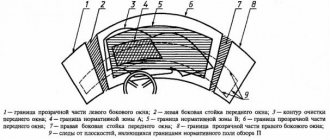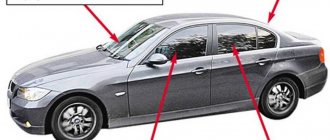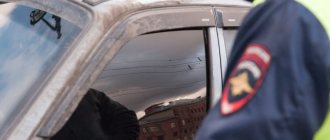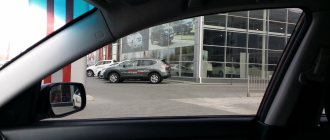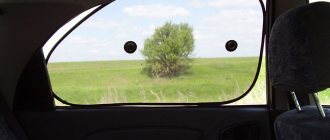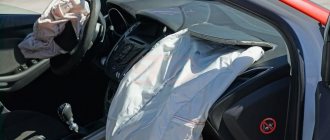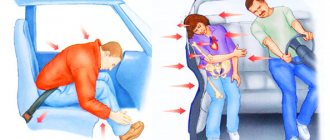Is it possible to use 50% tint?
To answer this question in detail, it is better to refer to regulatory documents. This will avoid fines and problems on the road. According to GOST 33997-2016 and the Technical Regulations of the Customs Union, only windshield tinting is regulated. And it must transmit at least 70% of light rays.
It turns out that tinting with a light transmission of 50% cannot be used on the windshield. This is fraught with a fine for non-compliance with technical standards.
Nothing is said about the side and rear windows. Here you can do tinting with the transmission of 50% of light rays. Although there is a small nuance here: when checking, the inspector may say that 50% darkening on the driver’s door interferes with visibility. It’s difficult to argue here; you’ll probably have to pay a fine. To avoid this, we recommend sealing the side windows with tinting of 70–75% or more.
If your car does not have side mirrors, but only a central one in the cabin, you should not use 50% tint either. In this case, the rear window is equivalent to the windshield. This means that at least 70% of the light must pass through.
Please note that you cannot use yellow film or mirror film. Even if it transmits 50% of the light. Such tints are prohibited for use on cars. The inspector will issue a fine without even taking measurements, just by looking at the car.
Photo gallery :: Car tinting
This gallery shows some photos of our glass tinting work. We tint cars only with high-quality American films at an affordable price. You can get more detailed information and see prices by following this link -Peculiarities
This tint is quite dense and allows a little light to pass through. The result is a pleasant twilight in the cabin, even on a bright sunny day. This makes the car more comfortable. Some types of films do not transmit ultraviolet radiation, which protects people sitting in the cabin.
At the same time, the coefficient “50” does not make the car tightly tinted. A person sitting in the passenger seat will see everything that is happening around. A good solution for families carrying children in the back - the child will be able to look around.
In some cases, using a film with a coefficient of “50” on the windshield can reduce the risk of getting a fine. If cars do not undergo general inspection, it is difficult to understand that this film transmits less light than allowed. Accordingly, the inspector will simply not pay attention to the passing car. But there is still the possibility of getting a fine.
At the same time, a film with 50% light transmission will not allow you to see what you are storing in the cabin. In many cases, this protects against theft; attackers simply do not see expensive items, which means the risk of illegal actions is reduced.
Another feature of tinting with fifty percent light transmittance is the ability to make the appearance of the car harmonious. It combines well with films marked “70” approved for windshields. There is no contrast transition.
avtoexperts.ru
Every day there are more and more tinted cars. And this is despite the fact that the law prohibits tinting the front side and windshields with a film whose light transmittance is below 70%. Typically, a film with a light transmittance of 5, 15 or 35% is chosen. It makes no sense to tint the front part with film according to GOST; there will be no darkening effect - this is exactly what many car enthusiasts think.
The owners are not embarrassed by a fine of 500 rubles, because it can be paid with a 50% discount within 20 days. So it turns out that for 250 rubles a month, the owner can afford to have a tinted car. In today’s article we will try to understand the pros and cons of this approach. Let's start with the positives.
Tinted Mercedes-Benz E-Class W212
1. Appearance . A car tinted in a circle looks mysterious and respectable. Almost always, such a car looks more impressive than the one without tinting.
2. It's not so hot in summer . The film prevents the penetration of ultraviolet and infrared rays of the sun, which means that in hot weather the interior will heat up less.
Tinted windshield
3. Sunglasses are no longer needed . During daylight hours, being in a heavily tinted car, the sun really does not blind your eyes.
4. Hide from prying eyes . Behind the dark windows you cannot see who is in the car. Suitable for people who want to remain private. Also, some argue that you can safely leave personal belongings in the cabin; no one will see them, and therefore will not steal them. Although in reality, if attackers decide to rob a car, then dark windows will not stop them.
Having listed the most common pros, let's move on to the cons .
1. Fine of 500 rubles . Although I wrote above that I paid the fine once a month and drive safely. In practice, a traffic police officer has the right to fine for such a violation every day. That is, they issued a fine for tinting, a day passes, and the same traffic cop can impose another fine. And, of course, he has the right to demand that the tint be removed, or that the car be taken to the impound lot.
In the photo - the driver removes the tint
How it happens in practice in real life depends on the region and the mood of the employees. In some places they treat tinting with kindness, but in others they force you to get rid of it. No amount of persuasion helps.
2. Poor visibility from inside . In the evening, when the sun sets below the horizon, visibility in a tinted car is significantly reduced. If the road is still visible through the windshield, then it is difficult to navigate using the side mirrors. The situation gets worse at night, especially on those sections of roads where there is no lighting. You can save the situation by opening the side windows, and if it is raining or snowing outside, then such a procedure will be extremely inconvenient.
Tinting from inside
3. Restricting visibility for other drivers . The situation was specifically with the author of these lines. When leaving the secondary road on the main road, I need to turn right. To my left stood a car with heavily tinted windows through which I could not see cars passing on the main road. I had to partially drive onto the main road and stick my head out to make sure that the passage was clear and I could drive.
You can't see anything through a tinted car
In conclusion, I will say that we are against tinting not according to GOST. The cons greatly outweigh the pros. For the sake of a supposedly beautiful appearance and an imaginary feeling of comfort in the cabin, the driver takes a significant risk, and also exposes other road users to danger.
As an option, athermal film can be applied to the front windows to meet visibility requirements. Tint the rear windows with a dark film, as this is not prohibited by law.
Materials
If you are concerned about tinting, you should choose the right material with which you will darken the glass. Film "50" can be of the following types.
- Painted. The cheapest option. Doesn't last long and fades quickly. But the most important thing is that there are often situations when the level of light transmission does not correspond to the declared one.
- Metallized. Some of the most durable. The film is three-layer; a metal coating is placed between two polymer layers. Protects well from ultraviolet radiation. In some cases, the radio signal is weakened, but this applies to options with a low level of light transmission. There are many similar solutions on sale labeled “50”. Just don’t take aluminum ones, they have a mirror effect and are prohibited.
- Sputters. Metal spraying is also used here, but it is embedded in one of the polymer layers. According to the manufacturers, the service life is unlimited.
- Colored. Most of them are prohibited from use. The same applies to the so-called “chameleons”, which change color depending on the intensity of light.
- Gradients. Such films have a slight transition in color or density. It looks good, but people of color may raise questions from traffic police officers.
- Athermal. They are characterized by a low level of transmission of thermal rays and ultraviolet radiation. The advantage is that the interior heats up little, which is simply irreplaceable in the summer. By choosing a tint with a light transmittance of 50% or less, you will additionally be reliably protected from ultraviolet exposure.
- Carbon. Graphite is sprayed onto the polymer. Such a film appeared recently and is practically not damaged when interacting with the environment. The matte surface does not glare. The only drawback is the high cost.
- Tinted glass. Usually they are installed on the conveyor. But, you can buy and install it yourself. A problem may arise if you want to remove the darkening, you will have to change the glass again. If you want to install this type of windshield with 50% transmittance, it will be difficult to find one.
- Removable toning. Budget, temporary option. Made from silicone. Looks cloudy and slightly dirty. Doesn't last long. It doesn't make much sense to put it on the car.
You should choose a method based on your capabilities, both financial and technical.
What to consider when choosing a tint film
Why is film so popular? It is not very expensive, and with its help you can even tint your car yourself.
- Type of film;
- The amount of light transmission;
- Manufacturer's name;
- Color scheme;
- Price.
Selecting the type of tint film
- Painted. These are the simplest and cheapest films. The dye in them is introduced into the polymer base, which creates a darkening effect. Such a film does not create glare and transmits radio waves well, but it does not last long, since the paint fades quickly. Nowadays such films are practically not used.
- Metallized. In this film, a layer of metal (usually aluminum) is also sprayed onto the painted layer. This layer is located between the protective and tinting layers, which is why car windows acquire a metallic tint. This type of film protects well from sunlight and heat without fading.
- Spatter. At their core, these are metallized films, only the metallization process is carried out using ion exchange. In this case, various chemicals can be applied to the polymer base. Spatter film has a good appearance and lasts a very long time (many manufacturers give it a lifetime guarantee, which is good news).
- Infinity film. This is a metallized film in which metal coating is located on the outside. Therefore, such a film reflects light even better (the degree of reflection reaches 70%). The glass acquires a mirror shine. However, the mirror effect is prohibited in our country, so these films are rarely used.
- Film with transition. In it, the sputtering density of the metal layer increases from bottom to top, so maximum protection from ultraviolet radiation is achieved only in the upper part of the car glass. That is, at noon, when the sun is very hot, the protection will be maximum.
- Energy saving film. This is an innovative film that removes glare, reduces strain on the driver's eyes, and prevents the passage of light into the car interior. Although the film appears transparent, it effectively protects everyone in the cabin from the sun.
- Carbon film. This is a modern, but very expensive type of film. So far it is rarely used. A graphite layer is sprayed onto such a film in a vacuum, which gives it good characteristics. Graphite provides excellent protection against ultraviolet rays. This film has all the advantages of metallized films, while it lasts a long time without losing its properties. The only drawback of this film is its high price.
- Sunscreen (protect motorists from ultraviolet rays);
- Impact-resistant (protect glass from mechanical influences. If glass with such a film breaks, the fragments will not harm passengers);
- Decorative (emphasize the style and individuality of the car owner).
Selection based on the percentage of light transmittance of the film
- 5% light transmission (passers-by will not see anything in the cabin);
- 10% light transmission (passers-by will only be able to see the approximate outlines of people in the car);
- 15% light transmission (silhouettes visible);
- 20% light transmission (you can see the faces of passengers);
- 35% light transmission (objects and people in the cabin are clearly visible);
- 50% light transmission (everything in the cabin can be seen without much effort).
Typically, car owners install tint films with a light transmission percentage of 10 to 35.
Selecting film by color
In addition, it is not advisable to buy film that is too cheap. It will only last a year or two and will have to be replaced. And these are additional costs.
conclusions
Tinting with a light transmittance of 50% is not prohibited, but it can only be used on the rear windows of a car without harming your wallet. It is not recommended to place it on the windshield, but it is not very noticeable, which is what drivers use. The inspector can determine the violation only through technical measurements.
In order for the film to serve you for a long time and not deteriorate its appearance, it should be chosen correctly. Pay attention to the type of material and its quality. It is better to entrust the sticker to an experienced craftsman. This way you are guaranteed to get an even tint without bubbles. Although, if you wish, you can do this yourself.
